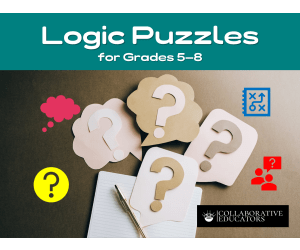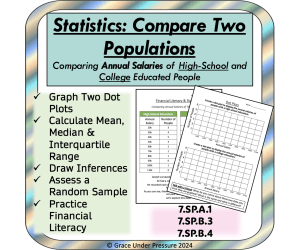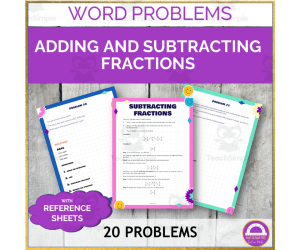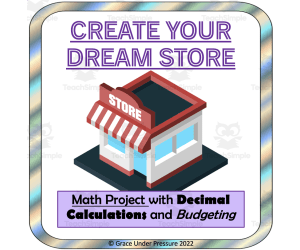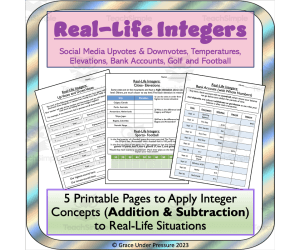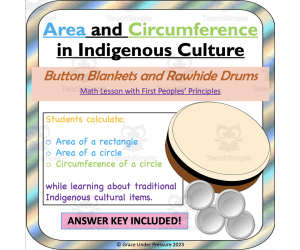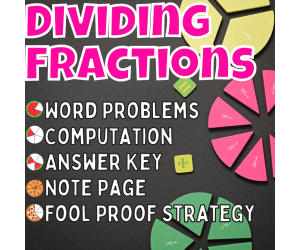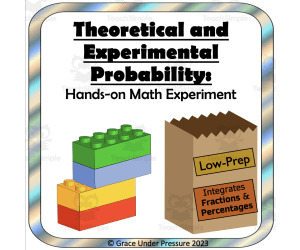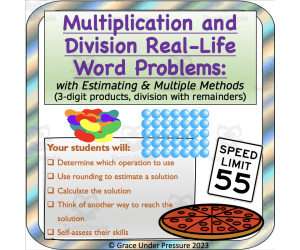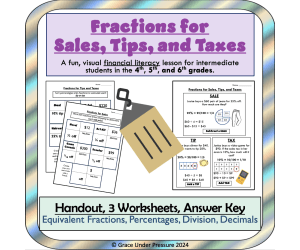2,756 products added recently
Middle School Word Problems
Provide middle school students with word problems spanning various topics appropriate for their level. These worksheets solidify foundational skills and promote logical reasoning. Use them to support continued mathematical development.
5th grade 6th grade Christmas Math Activity: Digital and Print
Common Core, Math, Addition and Subtraction, Decimals, Fractions, Graphing, Measurements, Money, Multiplication and Division, Grade 5, 6, Word Problems, Worksheets & Printables, Centers, Activities, Escape Room, Games
The time before the holidays can get a little crazy in the classroom. Students are ready for a break and teachers are too! Keep your class engaged with EIGHT Days of math review! The ACTIVITIES are suitable for 5th grade and 6th grade. They are great for easy and fast sub plans. I use them as an 'end of the day carrot' that my students look forward to. They can't leave for the day without getting a step closer to finding Santa so it helps them to stay focused throughout the day so that we have time for the fun activity at the end of the day. One of the best parts: NO PREP required! This is not only great for distance learning but also great if you have run out of copies for the month and need a digital version fast... or if you just forget to make your copies for the week. (It's happened to me! - too. many things to keep track of) The pages do print beautiful in color and black and white if you have the time, but don't fret if you don't. Just assign it on Google Classroom - directions included. If you haven't taught the topic yet, it is a great mini lesson and if you have taught it, it can act as a review. (There are also some fun logic puzzles sprinkled in.) dividing decimals multiplying decimals dividing whole numbers multiplying whole numbers adding decimals subtracting decimals deducing information measurement conversions practicing with money problem solving graphing predicting and having fun! Each task builds off the next. Students will get clues as to where Santa might be hiding AFTER they correctly solve each math task. And don't worry, there is an ANSWER KEY. This resource lends itself to independent work but students can also work in groups of pairs to solve. Don't forget about the other holidays! There is a themed math activity in my store for each of the following: St. Patrick's Day: Find the Leprechaun Easter: Find the Easter Bunny Cinco de Mayo: Find the Piñata
Author Big Apple Teaching
Tags Math Challenge, Find Santa, Decimals, Division, Multiplication, Word Problems, Logic Puzzle, Graphing, Money
6th Grade Math: Statistics and Probability Bundle: 4 Activities
Math, Statistics, Graphing, Money, Common Core, Grade 5, 6, 7, Worksheets & Printables, Word Problems, Activities
Do you need some new ideas for your 6th grade math unit to meet the Common Core State Standards for Statistics and Probability? Here is a ready-to-go bundle with four fun real-life activities to incorporate into your unit plan. 1) Statistical Questions: Students are taught what a statistical question is: a question that has numerical answers that vary.. 8 questions are included. Students need to identify if they are statistical questions or not. If they are, students think of how the data might be collected. If they are not, students explain what aspects of a statistical question are missing. Finally, students write 4 questions of their own (one should not be a statistical question) and they trade with a friend to see if they can identify the odd one out. 2) Dot Plots and Histograms: Students will collect numerical data through a survey and create their own dot plots and histograms to display their findings! This gives them a sense of ownership over their learning, and it is a great way to assess their skills! Discussion questions and self- assessment are included. 3) Math Stations: Statistics and Probability: Station 3 in particular has students create a dot plot and calculate the mean, median and mode of provided data. They can also do the probability stations if you want to address those skills. 4) Mean, Median and Interquartile Range of Hourly Wages: From a cashier to a taxi driver to an account to a CEO, students are given 10 realistic hourly wages. First, they create a histogram to display the data. Next, they write the wages in order from smallest to largest. They use this information to calculate the mean, the median, and the interquartile range. After that, they eliminate the outlier (the CEO wage) and recalculate the same statistics. Discussion questions are included. Grades to Use With: This bundle is designed for students in Grade 6, but can be used for Grade 5 enrichment, Grade 7 or 8 review, or high school special education classes. What's Included: 20 Page PDF with 4 Activities
Author Grace Under Pressure
Tags 6th Grade Math, Statistics , Probability, Dot Plots, Histograms, Mean, Median, Interquartile Range, Statistical Questions, Financial Literacy
Percent Word Problems: Tipping & Gratuities- Real World Math Worksheet
Life Studies, Home Economics, Special Resources, Life Skills, Math, Multiplication, Multiplication and Division, Percentages, Money, Grade 6, 7, 8, 9, Worksheets & Printables, Word Problems, Teacher Tools, Lesson Plans
Tipping is becoming more and more common and the amount you are expected to tip is increasing too. Make sure your students understand what tipping is and how to calculate a tip- useful life skills! Here’s a ready-to-print real-life percent math lesson for middle school students (in grades 6-9) or special education or life skills classes in a high school setting. Teach your class all about tipping culture and tips in both Canada and the United States. Why do people tip or give certain people a gratuity? What places do we tip? What places do we not? Has tipping been increasing recently ("tip-flation")? Show students how the math skills and concepts that they have been learning in class (percentages, decimals, division, fractions) can be useful in their everyday lives! How to Use: 1. The first page is a handout that you complete with your students (with fill-in-the-blanks) to teach them the ins and outs of tipping: where and when you do it, etc. 2. The second page teaches students two simple methods of calculating tips (using well-known percentage benchmarks OR multiplying the price by a percentage written in decimal form). Encourage your students to determine a third method they could use. 3. After that, there are 7 practice word problems of realistic tipping situations that your students can complete. From tipping for a meal to paying at a salon, or even calculating tax AND tip together, your students will get a lot of real-life practice completing these problems in small groups or own their own. 4. To finish, you can have a class discussion about tipping in general and what your students think about our system. What's Included: 6 Page PDF - Teacher Instructions - Handout with Fill-in-the-Blanks about Tipping - 3-Page Worksheet and Written Reflection - COMPLETE ANSWER KEY INCLUDED If you want more practice working with tips try these two products: Fractions for Calculating Taxes, Tips and Sales Percents for Calculating Taxes, Tips, and Sales
Author Grace Under Pressure
Tags Percent Word Problems, Tip, Tipping, Gratuity, How To Tip, How To Calculate A Tip, Financial Literacy, Life Skills, Personal Finance, Word Problems
Financial Literacy: My Party Budget- Decimals and Percentages Application
Life Studies, Finance, Home Economics, Math, Percentages, Decimals, Grade 5, 6, 7, 8, Worksheets & Printables, Word Problems, Activities, Projects
Financial Literacy: My Party Budget- Decimals and Percentages Application Unlock mathematics’ real-world influence with this practical math project for students in grades 5-8. This tool allows students to sharpen their intermediate math skills, particularly applying percentage calculations and decimal operations to manage a budget consciously - a vital lesson in financial literacy. This versatile resource is ideal for grades 5 to 8 classrooms as well as high school special education environments where budgeting practice complements life skills training. How to Use: Give each student a party budget. You can choose to give everyone the same budget, OR this is a great way to differentiate. Give students with emerging understanding a budget of $100 (which is easy to work with) and give students who need a challenge a budget such as $240, which will result in more complex calculations. This will also stimulate discussions about budgeting in general and the challenge of planning with less money. Students need to partition their hypothetical party budget across varied cost categories like food, decorations and entertainment by employing basic percent in decimal form and understanding addition and multiplication of decimals. For example, they might decide to spend 50% of their budget on food because that is their favourite part of a party. They will calculate 50% of their total budget. This skill application brings relevance to numbers through experiential learning. You can decide if students should complete calculations by hand or if using a calculator is allowed. Also, a complete sample answer key is included that you can show to your students to demonstrate the task. Finally, students complete shopping research and choose items online or in store flyers. This fosters strategic thinking when managing limited resources. You can have a discussion about making tradeoffs (for example, choosing frozen pizza instead of fresh to have extra money for a party activity OR inviting fewer guests to have more money for party favours per person). What's Included: A total of 8 pages in PDF Format Title Page Teacher Instructions 3 Page Student Worksheets 3 Page Sample Answer Key
Author Grace Under Pressure
Tags Financial Literacy, Decimals, Percentages, Budgeting, Math Application, Budget, Real World Math, Math Project, Applied Math, Party Project
5th Grade Summer Review or Practice Math Workbook
Math, Fractions, Graphing, Multiplication and Division, Order Of Operations, Addition and Subtraction, Algebra, Grade 4, 5, 6, Worksheets & Printables, Workbooks, Word Problems, Worksheets
Keep your students engaged and confident in math all summer long with this 5th Grade Summer Math Review Packet ! Designed to prevent the summer slide , this resource provides targeted practice on 20 essential 5th grade Common Core math skills —all identified as challenging concepts that lay the foundation for 6th-grade success . What’s Included? ✅ Teaching or note sheets for each skill ✅ Practice worksheets for reinforcement ✅ Detailed answer keys with step-by-step solutions ✅ Pre-review pages for select skills to refresh prior knowledge ✅ Teaching & tutoring tips for parents and educators Math Skills Covered: Multiply 2-digit numbers by 3-digit numbers Divide 4-digit numbers by 2-digit numbers Add, subtract, multiply, and divide whole numbers: word problems Evaluate numerical expressions with parentheses Convert decimals between standard and expanded form using fractions Compare decimal numbers (Ordering decimals included) Add and subtract decimals: word problems Multiply a decimal by a power of ten Multiply money amounts: multi-step word problems Divide by decimals Understand fractions as division: word problems Add and subtract fractions with unlike denominators: word problems Multiply two fractions Divide unit fractions and whole numbers: word problems Add, subtract, multiply, and divide mixed numbers Graph points from a table Multi-step problems with customary unit conversions Describe relationships among quadrilaterals Volume of compound figures Create and interpret line plots with fractions This packet is easily formatted to print and bind for a summer workbook or could be used individually in tutoring sessions or summer school lessons, as review worksheets. Practice could also help those that are skipping a grade in math, to ensure understanding of concepts that may be missed in the transition. Tags: 5th grade math review, summer math packet, prevent summer slide, 5th to 6th grade math transition, common core math worksheets, math tutoring resources, printable math workbook, summer school math activities, fractions and decimals practice, multiplication and division word problems
Author Kel's Klass
Tags 5th Grade Math Review, 5th Grade Summer Math Packet, Prevent Summer Slide, 5th To 6th Grade Math Transition, Common Core Math Worksheets, Math Tutoring Worksheets, Summer School Math Workbook, Adding And Subtracting Fractions, Multiplication And Division Practice
Halloween Themed Multi Step Word Problems with Long Division
Math, Multiplication and Division, Multiplication, Grade 4, 5, 6, Word Problems, Worksheets & Printables
Spice up October with some Halloween fun! Your students would even realize that they are also sharpening their math skills! I love a good theme to spice up math time and Halloween can be so much fun for kids. With this resource, teachers can also rest easy knowing that even though it has a fun Halloween theme, students are still getting the benefit of a rigorous math review. Why this resource? NO PREP for teachers! Just print and go. Easy Sub plans long division practice multi digit divisors perfect for the month of October Halloween themed How to use: set up stations around the room for students to travel to groupwork independent practice homework Do Now upon arrival bell ringer for the end of the day math center partner work You need this for the month of October! Easily and effortlessly sprinkle a little Halloween magic throughout the days in October and break free of your math book. It keeps students engaged and still practicing their long division with multi digit divisors when their mind is wondering. What will you get? There are 20 Halloween themed division problems that all involve multi-step word problems and multi-digit divisors. Perfect practice for grades 4-6. answer key Enjoy!
Author Big Apple Teaching
Tags Word Problems, Division, Math, Centers, Stations, Halloween, Activities, Multi-step, Double Digit Divisor, Grade 5
20 Logic Puzzles for Grades 5-8
STEM, Math, Science, Grade 5, 6, 7, 8, Games, Activities, Quizzes and Tests, Teacher Tools, Quizzes, Word Problems, Worksheets & Printables
Unlocking Logic: 20 Engaging Puzzles for Grades 5–8 is an entertaining and difficult set of brainteasers created to help middle school students improve their reasoning, critical thinking, and problem-solving abilities. There are 20 different puzzles in this ebook, such as logic grids, magic squares, numerical patterns, riddles, code-breaking, spatial thinking, and more. Every puzzle is designed to pique students' interest and promote original thought, which makes it ideal for early finishers, homework, enrichment, and classroom use. In order to engage a diverse variety of learners and facilitate flexible use across grades 5–8, the puzzles vary in difficulty and style. Pupils are urged to work alone or in groups, experiment with different approaches, and develop resilience by tackling problems carefully. To facilitate guided conversation and self-checking, a complete answer key is supplied. Whether you're a teacher looking to inspire your class or a parent wanting to support logical thinking at home, this ebook is the perfect companion for building sharp minds—one puzzle at a time!
Author Bright Classroom Ideas Marketplace
Rating
Tags Riddle, Logic, Puzzle, Quiz, Grade 5
Statistics Word Problems: Compare Two Data Sets of Annual Salaries
Math, Graphing, Measurements, Statistics, Grade 6, 7, 8, Worksheets & Printables, Worksheets, Word Problems
This middle school math lesson allows your students in grades 6-8 to apply the statistical skills they have been learning in class to a real-world financial literacy scenario: the annual salaries of workers who have a college degree compared to those who do not have one. It is a real world math activity that includes five worksheets all ready to go! Your students will: - Make two dot plots to display two data sets (that are included with the lesson): wages for people with a college degree and those without - Share observations about the distribution of data in each set - Calculate the mean, median and interquartile range for each data set - Draw inferences about whether there is an effect of a college education on someone's annual salary - Consider if the sample that was used is representative This lesson was designed to specifically address 7th Grade Common Core Math Standards for the Statistics and Probability strand: 7.SP.A.1 7.SP.B.3 7.SP.B.4 What's Included: 7 Page PDF- Ready to Print and Use! - Title Page with Teacher Instructions - Student Handout that has Two Data Sets (with 20 items each) - Dot Plot Worksheet (for students to graph and compare two dot plots) - 2-Page Measures of Central Tendency and Variation Worksheet - Reflection Worksheet - Answer Key If you enjoy this statistics lesson, check out other fun options in my store: Middle School Math Stations or Centers for Statistics and Probability: 5 Math Centers that are a great way to prepare for a unit test! Create Dot Plots and Histograms: 6th Grade Statistics and Graphing Practice: Students create and carry out their own survey and then graph it two ways! Identifying and Writing Statistical Questions for 6th Grade Math: Help your students learn ways to collect data and try it out!
Author Grace Under Pressure
Tags Statistics, Compare Data Sets, Financial Literacy, Dot Plots, Statistics Word Problems, Compare Data Distributions, Mean, Median, Interquartile Range, Graphing Data
Multi Step Word Problems | Adding and Subtracting Fractions
Math, Fractions, Grade 5, 6, 7, Word Problems, Worksheets & Printables
This comprehensive no-prep tool is designed to make the complexities of working with fractions easy for your students. To make your teaching and your students' learning easy, this resource comes complete with a two-page reference sheet that serves as a quick review on adding and subtracting fractions. Whether your students need a refresher or an initial understanding, this reference sheet is a valuable help. Each problem in this set is carefully crafted to challenge and engage students, providing real-world scenarios that require the application of adding and subtracting fractions with unlike denominators. But what truly makes this resource more valuable is the inclusion of detailed, step-by-step solutions for every problem. This feature ensures that students not only tackle the problems but also understand the underlying concepts. No more confusion or uncertainty – this resource empowers your students to grasp these fundamental mathematical principles with confidence. This resource is a great addition to your teaching arsenal and can be used effectively in various scenarios, making it perfect for: Morning Work: Kickstart your students' day with engaging multistep word problems that foster critical thinking and mathematical skills. Homework: Reinforce learning outside the classroom by assigning these problems as homework, allowing students to practice and consolidate their knowledge. Small Groups or Large Group Instructions: Adapt the resource to your class size and teaching style, whether it's a collaborative small group activity or a whole-class instruction. Early Finishers: Keep your fast-paced learners challenged and occupied with these enriching problems that promote mathematical thinking. Emergency Sub Plan: Ensure uninterrupted learning even when you have a substitute teacher by having this resource ready to go. This resource empowers both teachers and students with the tools needed to learn these essential mathematical concepts. Make learning fractions an engaging and rewarding experience, and watch your students thrive in their mathematical journey.
Author Matemaths
Tags Matemaths, Worksheet, Fractions, Word Problems
Financial Literacy: Compound Interest
Life Studies, Math, Decimals, Money, Finance, Home Economics, Business, Grade 8, 9, 10, 11, 12, Worksheets & Printables, Word Problems, Activities
This high school financial literacy lesson will show students why compound interest is so helpful to investors! The first page walks students through how to calculate compound interest step-by-step (year-by-year). Students need a basic understanding of writing percent as a decimal and multiplying to find the "percent of" a number. Students will be given an initial investment and a yearly interest rate. Each student in the class can have different values so they have to do their own work and so comparisons can be made. This allows for easy differentiation as well- give students who are struggling an easier interest rate (10%, 1%) and students who need a challenge a trickier one (6%, 4.5%) Students carefully calculate the amount of compound interest they would earn over ten years. They check their work using the compound interest formula. Then they can use the formula to calculate compound interest for longer periods of time. Your class can compare their results. I would recommend having a class discussion (prompt questions are included). Make sure to point out how compound interest is great for investing and saving and terrible for borrowing money. It works against you when you have a loan. Finally, students reflect on their learning by writing a paragraph after the lesson, and hopefully leave class wanting to start a saving account! This step-by-step lesson clearly shows students how compound interest works. They get practice doing calculations with precents written as decimals, exponents, and order of operations. It is the kind of math lesson that will stay with students long after the year is complete! Also check out my Financial Literacy Interest Rates: Lending and Borrowing Money Lesson!
Author Grace Under Pressure
Tags Financial Literacy, Compound Interest, Investment, Yearly Interest, Money, Personal Finance, Interest, Loans, Budget, Percent, Compound Interest Project, Compound Interest Lesson
Fall Number Flashcards – 0–30 Memory and Sequencing Games
Holiday & Seasonal, ELA, Special Resources, Special Education Needs (SEN), Seasons, Fall, Math, Early Math, Numbers, Counting, Preschool, Grade 1, 2, 3, 4, Activities, Games, Worksheets & Printables, Quizzes and Tests, Teacher Tools, Quizzes, Projects, Flashcards, Word Problems, Centers
Fall Numbers Memory Game Bring autumn fun into your math lessons! This set of fall-themed flashcards gives students repeated practice with numbers from 0 to 30 in a playful and flexible format. I first made these for my kindergarten class, when many of my students still needed support with recognizing numbers and putting them in the right order. The cards worked well because they could be used in so many different ways without having to prepare something new each time. There are 228 cards in total, divided into six full sets with different colored borders. The colors make it easy to keep groups organized, since each table can use a separate set without mixing the cards together. Each card shows a single number in a large, clear font, which helps beginning learners and also supports students who struggle with visual distractions. The cards can be used for memory or matching games, where students flip over two at a time and try to find pairs. Another favorite activity in my class has been sequencing: students work together to lay the cards out from 0 to 30. For more active lessons, we sometimes spread the cards on the floor and have students “walk” the numbers in order, which adds movement to the practice. I also use the cards as simple flashcards, holding them up for quick recognition drills, or handing one card to each student and asking the group to line up in numerical order. With partners, students have created their own math problems using the numbers they draw, which adds a layer of challenge for more advanced learners. Differentiation is built in, since you can choose how many numbers to include. With beginners, I usually work with 0–10. As students grow more confident, I extend to 0–20 and eventually the full 0–30. Adding a timer or encouraging students to say each number out loud when they play can make the activity even more engaging. Preparation is straightforward: print the set you want, cut the cards, and laminate if you plan to reuse them. I keep each set in small envelopes or bags so they are ready for math centers, group games, or quick warm-ups. The fall design adds a seasonal touch, but the number practice is useful all year long. Warm regards, Lernfitness Did You Know? I teach with a certified therapy dog, and together we focus on creating a positive and inspiring learning environment.
Author Lernfitness
Rating
Tags Foreign Languages, Game, Educational Card Games, Elementary, Fall, Memory, Numbers, Counting, Autumn, Math
Math Project: Create your Dream Store: Decimal Calculations and Budgeting
Life Studies, Math, Addition and Subtraction, Addition, Decimals, Money, Finance, Business, Career, Grade 5, 6, 7, 8, Worksheets & Printables, Word Problems, Activities, Projects
This is an engaging math project that lets students apply math skills to a realistic situation: opening their own store! Grades to Use With: This project is perfect to use with your middle grades students in grades 5-8. It could also be a great addition to a high school life skills class studying finance, business, or careers. How to Use: Each of your students has won $2,000,000 in the lottery, and they are going to use it to open their very own store! They create a budget for a new business venture by considering the costs to rent a commercial storefront in your area, pay employees, and buy all of the supplies and stock they will need. They can do research on the internet to find out the prices of rental properties and the supplies they will need. They can do decimal calculations by hand or with a calculator. This will include adding decimals and multiplying decimals. Extension: Students who finish early can create an advertisement to attract customers to their new store. You could even have a day where each student presents their unique store idea to the class. Standards: CCSS5.NBT.B.7 Add, subtract, multiply, and divide decimals to hundredths, using concrete models or drawings and strategies based on place value, properties of operations, and/or the relationship between addition and subtraction; relate the strategy to a written method and explain the reasoning used. CCSS7.NS.A.3 Solve real-world and mathematical problems involving the four operations with rational numbers. If you enjoy this math project , check out some other options in my store: Math in the Real World: Personal Math Research Project for STEM, Enrichment, or Early Finishers Financial Literacy: Household Budget Project: Taxes, Insurance, Loans, Rent, Groceries and More!
Author Grace Under Pressure
Tags Math Project, Store Design, Budget, Decimal Calculations, Group Work, Financial Literacy, Applied Math, Money, Business, Project, Budgeting Project For Highschool Students
Writing and Solving Multi-Step Equations Word Problems Pixel Art
Math, Algebra, Grade 8, 9, 10, Word Problems, Worksheets & Printables
Self-Checking, Multi-Step Equation Word Problems This engaging no-prep resource is designed for eighth grade students to provide them a way to practice writing and solving multi-step equations from word problems. There are twenty logic puzzles that are paired with a fun anecdote. While students work the problems, they will discover pixels of an image, this will keep them engaged and want to finish the work so they can see the picture. The self-checking function encourages independent work, allowing mistakes to bubble up and be corrected with less teacher involvement. This digital activity is designed to review linear equations and keep your students involved and willing to learn. Why you need it: Zero Prep: just copy the link and send it to your students. They will be ready to start working immediately. Self-Checking for Independent Learning: Students receive instantaneous feedback after each question; if the answer is wrong, nothing shows up, and they can't go to the next question. In other words, students learn independently, build confidence, and ask for help only when they really need it. Pixel Art Keeps Students Engaged: Every single correct answer reveals part of a pixel art image, making math practice a fun and interactive challenge. The idea of this visual reward system keeps students motivated. Humor Meets Learning: Each word problem is accompanied by a joke that makes the math practice not so boring. It is a perfect way to keep students entertained while working through challenging multi-step equations. Versatile for Any Learning Environment: Classroom use, homework, test review, or math centers-this binder-free resource smoothly transitions into any environment you see best. Moreover, it is perfect for sub plans; your kids are sure to learn something even when you're not there. What's Included: 20 Multi-Step Equations Word Problems: Thoughtfully designed for 8th grade. Printable Handouts and Task Cards: Insert these printables for independent activities, group work, or learning stations. The task cards are perfect to get your students moving while learning or working in centers. Detailed Solutions Included: Each problem has a detailed solution so the students can easily check their work or the teacher can quickly review answers. Interactive Digital Format: This resource is flexible to fit your classroom needs-printed or used digitally. This Multi-Step Equations Word Problems Pixel Art activity is designed to make life easier. With the self-checking format, students can work at their own pace and seek help only when they need it, freeing you to give targeted guidance as they master these foundational math concepts. Jokes, colorful pixel art, and the autonomy of self-checking tasks are sure to make this an enjoyable activity for students.
Author Matemaths
Tags Matemaths, Algebra, Equations, Pixel Art, Word Problems, Multi Step
Real-Life Integers: Working with Integers & Number Lines Grade 6 Math
Math, Number Lines, Addition and Subtraction, Addition, Subtraction, Numbers, Grade 5, 6, 7, Worksheets & Printables, Word Problems, Activities, Worksheets
Integers are everywhere in our lives! Get your students excited about learning about integers including using number lines and finding the difference between integers in a variety of real-life situations. This is perfect for students in grade six who are first learning about rational numbers. Social Media: Up Votes and Down Votes: You will read each statement one at a time to your class. Then ask for upvotes (and count the hands) and ask for downvotes (and count the hands). Remind students they can abstain from voting on a statement if they are ambivalent. If you think it will help your class, have students vote anonymously by putting their heads down. Record the upvotes and downvotes for each of the 10 statements. Students complete the math (which is really adding integers) to get each statement’s final score. (Extension: This activity can lead to a mini-lesson on facts vs. opinions.) Cities: Temperatures and Elevations: Students will need internet access for this activity. They will explore two cities: one with a positive temperature in degrees Celsius and one with a negative temperature in degrees Celsius. Using a number line, they will compare these two temperatures. Then, they must find the elevation (in meters) of six cities around the world to complete three math questions. Sports: Golf and Football: Students will apply adding and subtracting integers to a golf game to calculate the player’s score above or below par. Then, they use integers to calculate if a football team scores a touchdown. (Extension: Students can create their own football scenario. They can choose a starting point, make up 5 plays, and trade with a friend. ) Financial Literacy: Bank Account: Students add and subtract integers to keep a running bank balance in an account with an overdraft. They see how purchases reduce your balance and deposits increase your balance. I have included two versions, one with decimals and one with whole numbers only.
Author Grace Under Pressure
Tags Integers, Adding Integers, Grade Six Math, Sixth Grade Math, Subtracting Integers, Word Problems, Real-life Math
Circumference and Area of Circles (with First Peoples' Principles)
Social Studies, First Peoples (Native), Math, Geometry, Measurements, Grade 6, 7, 8, Worksheets & Printables, Word Problems, Worksheets
Circumference and Area of Circles with First Peoples' Principles is a teaching resource that combines math education with a basic introduction to two cultural traditions from indigenous groups. It is suitable for middle grades students in 6th to 8th grades. This lesson provides a practical application of geometry by instructing students on how to calculate the areas of rectangles as well as the area and circumference of circles. The lesson plan blends hands-on activities with relevant mathematics concepts, helping students to understand math theory through real-life tasks. 1) Students learn what a button blanket is and its cultural significance. They measure the area of a "blanket" and calculate the area of the "buttons." Then, they cut out the buttons and glue them on the blanket in a design. Finally, they calculate the area of the blanket that is not covered by the buttons. 2) Students learn what a drum is and its cultural significance. They calculate the circumference of the "drum." Then they determine the area and circumference of a piece of rawhide that would be needed to overhang and cover the drum. This flexible lesson can be used in whole-class sessions to guide every student step by step. It may also serve as a resource for small group work or homework assignments, promoting independent problem-solving skills outside school hours. Grades to Use With: This product is specifically designed to align with the British Columbia Mathematics 7 curriculum requirements, but it can fit into any learning environment studying circle areas & perimeters - ranging from middle school math classes, high school social studies lessons, or high school special education. The worksheets also help meet CCSSMP1 standards. What's included: An easy-to-follow four-page PDF including two student worksheets. An answer key for teachers to accurately assess student progress through each exercise. If you enjoy this math activity , check out many others in my store: Grace Under Pressure
Author Grace Under Pressure
Tags Circles, Geometry, Indigenous Culture, Area, Circumference, Radius, Diameter, Button Blanket, Drum, Area Of Circle
Math Journal: Experimental Probability with Two Independent Events
ELA, Math, Percentages, Fractions, Statistics, Writing, Grade 5, 6, 7, 8, 9, Worksheets & Printables, Word Problems, Activities
Math Journal: Experimental Probability with Two Independent Events This resource serves as a helpful teaching tool for educators focusing on the concepts of experimental probability and theoretical probability of two independent events in middle school mathematics. It offers an engaging math journal entry exercise that allows students to explain their mathematical thinking in pictures, numbers, diagrams, and words. How to Use: Students are given the following question: You have a six-sided die and a penny. If you roll the die twice and flip the penny twice, which is more likely: to get two sixes on the die or two heads from the penny? Explain your thinking using pictures, numbers, and words. Can you figure out the percentage chance of each event happening? Give students dice, coins, and mini whiteboards to work with so they can start to test out their ideas and theories. Encourage students to tackle the penny first as there are fewer results when flipping two coins. Suggest that students work together in pairs or small groups and use a table or chart to record the experimental options that could occur. You may want to start by teaching a mini-lesson about the probability of two independent events: that one multiplies the probability of each event to determine the probability of BOTH events. Grades to Use With This resource is ideal for use with students in grades 5-9 but can also be used as special education material or enrichment content for gifted children aged between grades 4-6. Finally, it could be used in a high school special education classroom. What's Included: This two page PDF is ready to print and go! If you enjoy this math journal entry, check out my bundle of 20 Middle School Math Journal Entries or my Math Journal Rubric for easy marking. Or, explore other probability items in my store.
Author Grace Under Pressure
Tags Math Journal, Experimental Probability, Two Independent Events, Middle School, Probability, Dice , Coins, Chance, Middle School Math, Fractions
Dividing Fractions Review of Word Problems and strategy
Math, Fractions, Grade 4, 5, 6, Word Problems, Worksheets & Printables
Looking for a catchy way to get students to remember how to divide fractions? Welcome to KCF or Keep Change Flip. This strategy is sure to help your students unlock the difficulty with dividing fractions. Dividing Fractions has a lot of important steps... that are often missed by students. By using this resource, you will ensure that your students will never miss a step again! Because miss one step and your answer is wrong. What will you get? cheat sheet of notes for students step by step: how to divide fractions practice dividing with word problems How to use in the classroom: You can use these for an around the room day where you post 10 dividing fractions word problems around the room and students answer each one you can give all 10 problems at once for group or partner work leave a packet at a Dividing Fractions Math Center great for in a pinch sub plans extra practice for homework morning 'Do Now' This fool proof strategy is bound to help your struggling learners find a groove with dividing fractions. After using this resource your students will be able to: fluently divide fractions decipher word problems involving division of fractions explain the process of dividing fractions Have fun practicing dividing fractions with your class
Author Big Apple Teaching
Tags Dividing Fractions, Division, Word Problems, Strategies, Notes, Math Center, Math Station, Fractions, Review, Test Prep
Ratios, Rates, Percentages Worksheets: Applied Math Housing Math
Special Resources, Life Skills, Life Studies, Home Economics, Finance, Math, Percentages, Fractions, Grade 6, 7, 8, 9, Worksheets & Printables, Word Problems, Worksheets
Would you like to show your middle grades students in grades 6-9 how the ratio and rate math skills (percentages, fractions, ratios, and rates) that they have been learning in the classroom can be helpful in their real lives? Would you like to incorporate more useful life skills in your math class? Then, show your students all the ways math can be used in buying and/or renting homes! This makes math meaningful and helps engage reluctant learners! What's Included: 6 pages of worksheets that are ready to print and use (great to make a booklet or mini-unit) A Complete Answer Key is Included 1) Design Your Floorplan: Students will design a simple one-storey house that includes five rooms and hallways. They will calculate what percent of the home each room occupies. 2) Down Payments: Students will calculate the down payment & mortgage loan amount for different scenarios using whole-number percents or fractions. 3) Mortgage Payments: Students will use ratios, fractions, or percentages to help calculate how much of their monthly mortgage payment will go to interest & how much will go to paying down the loan/principal. 4) Interest Rates: Students will calculate a monthly interest payment using a variety of past interest rates. They will multiply the mortgage amount owing by the percent (written as a decimal) and then divide by 12. 5) Square Foot per Person: Students will practice calculating a simple real-world rate: square feet of living space for each person in a home. This can vary a lot in different cities and with different family situations. 6) Cost per Square Foot: Students will calculate another common rate: cost per square foot. They will compare four price points for buying and four more options for renting and determine the best deal for each situation.
Author Grace Under Pressure
Tags Ratio Worksheets, Rate Worksheets, Percent Worksheets, Percentage Worksheets, Ratios And Rates, Percent, Housing Math, Life Skills, Applied Math, Buy A House
Theoretical & Experimental Probability: Hands-on Math Task with Fractions and Percentages
Math, Percentages, Fractions, Statistics, Grade 4, 5, 6, 7, Worksheets & Printables, Word Problems, Activities
Theoretical and Experimental Probability: A Hands-On Math Exercise (with Fractions and Percentages) This is a ready-to-use, engaging, two-page math activity designed for intermediate students in grade levels 4 through 7. The product lets your students easily conduct a simple probability experiment that will help them grasp the concepts of theoretical and experimental probabilities. They will also tie this learning into other math topics by converting fraction results into percentages. Items Needed: Paper bags filled with items that are red, yellow blue, and green. Ideal items can be Legos, blocks or counters. Bags should contain amounts of items that will easily convert from fractions to percentages- so 5 items, 10 items, 20 items, or 25 items are ideal. Features: Fits seamlessly into any probability or percentage unit Serves as excellent practice for reinforcing equivalent fraction and percentage concepts How to Use: Split students into small groups. Give each group a bag of items and a worksheet (double-sided) for each member. Students will explore their bag: count the total number of items, count how many there are of each colour, write each colour as a fraction, and convert that to a percentage. This is the theoretical probability of each event. Then they perform the experiment: pulling one item from the bag and replacing it twenty times. They will use a tally chart to record the colours pulled. They will turn their results (fractions out of 20) into percentages. This is the experimental probability. Finally, students reflect on if the theoretical and experimental probabilities matched or did not and why that could be. Grades to Use With: This activity is designed for students in grades 4-7 who are learning about equivalent fractions, percentages, and probability experiments. What's Included: 3 page PDF: Title Page and 2-page handout. Copy double sided and you are ready to go!
Author Grace Under Pressure
Tags Probability Experiment, Theoretical Probability, Experimental Probability, Fractions, Percentages, Math Experiment, Hands-on Math, Probability, Math Activity, 7th Grade Math
Life Skills: Nutrition Facts Math Percentages, Ratios, Rates
Special Resources, Life Skills, Home Economics, Life Studies, Math, Percentages, Multiplication and Division, Grade 5, 6, 7, 8, Worksheets & Printables, Worksheets, Word Problems
Healthy eating is a key life skill! Do you want to teach your class how to accurately read a nutrition facts label and determine the healthy and less healthy aspects of the food choices they make? Do you want to find a way to apply the math skills you have been teaching in your middle school classroom (percentages, rates, ratios) to a real-life engaging situation? This is the lesson for you! This ready-to-print lesson for students in 5th to 8th grades includes an eye-catching one-page handout to teach students the basic vocabulary and terms included on nutrition facts labels: - absolute amount in grams or mg or mcg & percent of Recommended Daily Intake (RDI) - suggested serving size (grams) - calories - fat, protein, carbohydrates - sodium - vitamins and minerals There are three different worksheets to allow students practice the following life skills: • Determining the number of servings in a package (you mean I'm not supposed to eat the whole tub of ice cream in one sitting!?). • Calculating the amount of nutrients and calories they would get if they ate several servings (which we often do!). • Comparing sugars that are naturally occurring vs. added. • Using simple percent calculations to determine the Recommended Daily Intake of vitamins. • Comparing two similar foods (frozen yogurt vs ice cream) to see which is a healthier choice and why. And more! What's Included: 6 Page PDF Ready to Print and Use! - Title Page and Teacher Instructions - Student Handout: The Basics of Nutrition Facts Labels - Potato Chip Nutrition Facts Label (with Math Questions) - Dried Apricots Nutrition Facts Label (with Math Questions) - Ice Cream vs. Frozen Yogurt Nutrition Facts Labels (with Math Questions) - Complete Answer Key If you like this lesson, check out other grocery lessons in my store: Grocery Shopping Price Comparisons Grocery Shopping on a Budget Grocery Game
Author Grace Under Pressure
Tags Word Problems, Life Skills, Real World Math, Nutrition Facts, Nutrition, Nutrition Facts Label, Percentage Word Problems, Rate Word Problems, Grocery Shopping, Family Consumer Sciences
Real-Life Long Division Word Problems and Multiplication Word Problems
Math, Multiplication and Division, Multiplication, Division, Grade 4, 5, 6, Worksheets & Printables, Word Problems, Activities, Worksheets
In this math lesson, your students will Learn the definitions of multiplication, division, and estimating Determine which operation to use (multiplication or division) to solve a real-life word problem Use rounding and benchmarks to estimate a solution Calculate the solution with the standard algorithm Think of another way to reach the solution Self-assess their skill Grades to Use With: This lesson is designed for students in grades 4-6 who are learning and/or practicing their multiplication and division skills using the standard algorithm AND a variety of other estimating and benchmark methods. It includes three-digit products, one-digit divisors, and division with remainders. How to Use: Go over the first page together as a class. Review the definitions of multiplication, division, and estimating. Then complete the first word problem together- modelling the 4 steps: choose the operation, estimate, solve, and solve using an alternate method. Then you can let students work on the five other problems independently or in small groups. They could do some of the problems in class and a couple of them for homework. I have included a quick self- assessment at the end, so you can see which steps students are confident with and which are a bit more challenging. My students often struggle to think of an alternate method to solve the problem, so I can target some small group support for that skill. What's Included: 6 Page PDF Title Page Student Definitions and Sample 3 Pages of Student Questions and Self- Assessment Answer Key If you enjoy this real-world math activity, check out others in my store: Create Your Dream Store with Math Calculations and Budgeting Grocery Game: Working with Decimals (Estimating, Multiplying, and Adding) Real-Life Math Assessment for a Line Graph Unit: Scale, Interpreting, and Graphing Data Gingerbread Math: Fractions, Decimals, and Percentages Using Tenths Financial Literacy: My Budget Project Math Project: Circle Graphs and Pie Charts
Author Grace Under Pressure
Tags Multiplication, Division, Word Problems, 5th Grade Math, 4th Grade Math, 6th Grade Math, Estimating, Multiple Methods, Long Division Word Problems, Multiplication Word Problems
Financial Literacy: Financial Trade-offs
Special Resources, Life Studies, Life Skills, Finance, Home Economics, Math, Money, Grade 7, 8, 9, 10, 11, 12, Worksheets & Printables, Word Problems, Activities
Financial Literacy: Financial Trade-offs Here’s a quick and simple way to include some easy financial literacy learning into your middle, high school, or special education class. These 8 prompts describe realistic financial scenarios about work, housing expenses, post-secondary education, cars, retirement planning, and wedding costs. Use them as debate topics, research prompts, or a simple whole class discussion (ideal for those extra few minutes you often end up with before the end of class). Only simple math skills and basic financial vocabulary are needed to understand these topics. How to Use: Start by explaining the basic premise to your students: Often people can feel stuck in their life due to a financial issue. However, by making a few financial trade-offs, there is usually a different way to deal with issues. Here are eight real life scenarios that many people deal with. Discuss them with your peers, have a debate, make a list of pros and cons! Realize that you always have more options if you can think critically and creatively. Main Goal: The main goal of these prompts is to drive home the importance of understanding trade-offs in goal setting and financial planning. Each topic presents itself as a relatable real-life scenario offering two distinctive choices involving critical thinking and decision-making. There is no "right" answer: just the right answer for your situation. Grades to Use With: These prompts could work in a middle or high school math class, a personal planning or career and education class, or a high school special education classroom. They could even be used in adult education scenarios. What's Included: A total of 10 pages in PDF: Title Page, Instruction Page and 8 trade-off situations If you enjoy this financial literacy product, please check out some of my other options in my store: FIRE: Financial Independence Retire Early Compound Interest: Hook Students on Financial Literacy Net Worth: Assets - Liabilities = Equity
Author Grace Under Pressure
Tags Financial Literacy, Trade-offs, Critical Thinking, Budget, Money, Life Skills, Real World Math, Finance, Planning, Personal Finance
Fractions Word Problems: Using Fractions for Taxes, Tips, Sales
Math, Fractions, Money, Life Skills, Special Resources, Grade 4, 5, 6, Worksheets & Printables, Word Problems
Here’s a fun, engaging, and visual personal finance lesson for middle grades students in the fourth through six grades. They can use the math they have been learning in the classroom applied to a real-life scenario: learning how to calculate taxes, tips, and sale discounts. Math Skills Used Equivalent Fractions (especially using a denominator of 100) Percentages Division (for example, to find a 20% discount, divide by 5) Money Decimals Addition and Subtraction This guided math lesson includes a clear and concise one-page handout that provides visuals to teach your students how to use fractions to help calculate sale prices, sales taxes, and tips. Next, the lesson includes three worksheets for your students. These are created to be of increasing levels of challenge. Assign one, two, or all three! Differentiate for your students' specific needs. First students calculate sale prices using fractions by applying simple division. Next they can calculate sale prices using percentages that are easily converted to fractions. Finally, they can practice calculating tips and taxes using simple percentages as well! A complete answer key is also included. Grades to Use With: This lesson is designed for students in grades 4-6 who are learning about fractions, equivalent fractions, simple percentages, ratios, and decimal operations. It could also be appropriate for middle or high school special education classrooms depending on your students' needs. What's Included: 6-Page that is ready to print and use! Teacher Instructions Student Handout 3-Page Worksheet Answer Key If you find this personal finance lesson useful, check out others in my store: My Budget Project for Grades 3-6: This lesson shows your students how to budget for housing, food, transportation and more! Valentine's Day Math Activity: Budgeting and Financial Literacy: This fun math lesson lets your students "shop" for Valentine's gifts for their friends while sticking to a budget. G rocery Shopping Price Comparisons: This is a great way to practice percentage and rate math: finding the best grocery deal.
Author Grace Under Pressure
Tags Fractions, Taxes, Tips, Sales, Financial Literacy, Math Word Problems, Fraction Word Problems, Applied Math, Tax, Tip
Understanding Integers: Graphing Integers on a Number Line
Math, Number Lines, Early Math, Algebra, Grade 5, 6, 7, Worksheets & Printables, Word Problems, Worksheets
What is an integer? On what side of the number line will they be? This resource is perfect practice for students who are being introduced to integers. Students will know the difference between a negative number and positive number. Each worksheet contains a number line for visual aid and representation. Students are to graph each integer shown and by doing so, students will have more understanding of where the number is located on a number line. These integers may be in a set or individual. Students will also read real world examples of negative and positive numbers and decide where to graph each on a number line. Additional practice is included for students to tell the value of a letter shown on the number line. With the 5 different activities included in this set, it is a great introduction to integers and to set the foundation for future problems regarding integers. Includes: 5 practice pages answer key Check out the thumbnails to get an idea of what the pages will look like. Thanks! Understanding Integers: Graphing Integers on a Number Line Understanding Integers: Graphing Integers on a Number Line Understanding Integers: Graphing Integers on a Number Line Understanding Integers: Graphing Integers on a Number Line Understanding Integers: Graphing Integers on a Number Line Understanding Integers: Graphing Integers on a Number Line Understanding Integers: Graphing Integers on a Number Line
Author Soumara Siddiqui
Tags Integers, Integers On A Number Line, Graphing Integers








